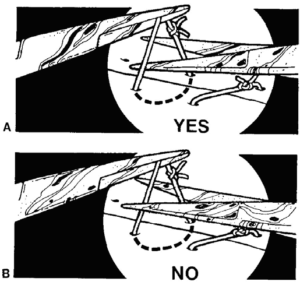a. General Considerations. Suture removal should be timely enough to avoid suture marks, yet not so soon as to risk the wound splitting open.
See table 2-1 for the approximate times for suture removal by body region.
When the patient returns for suture removal, assess the wound to be sure it is mature enough for suture removal. If the wound is not sufficiently healed, tell the patient to return in two days for suture removal. When you are removing sutures, be certain to cut only the thread of the suture loop and not two threads (figure 2-14). Otherwise, part of the suture will be retained below the skin surface.


b. Principles of Suture Removal. Follow these principles.
(1) Use sterile forceps or hemostats and proper suture scissors (sharp point down).
(2) Cut the suture at skin level.
(3) Do not pull a contaminated suture through the suture route.
(4) Pull the suture up and towards the wound at a 45-degree angle.
(5) Pull the suture gently and smoothly.
(6) Support the suture at the suture exit point.
